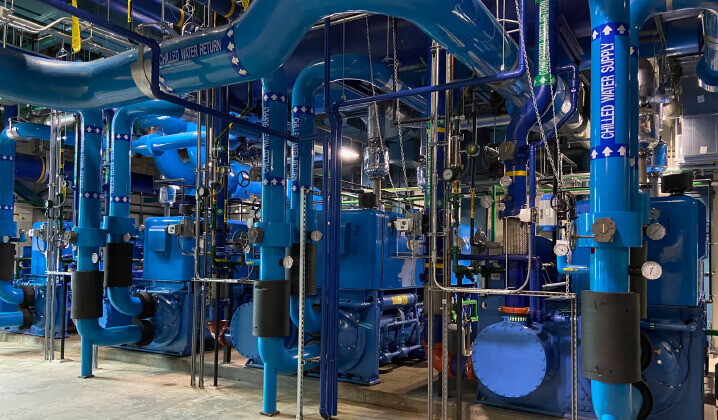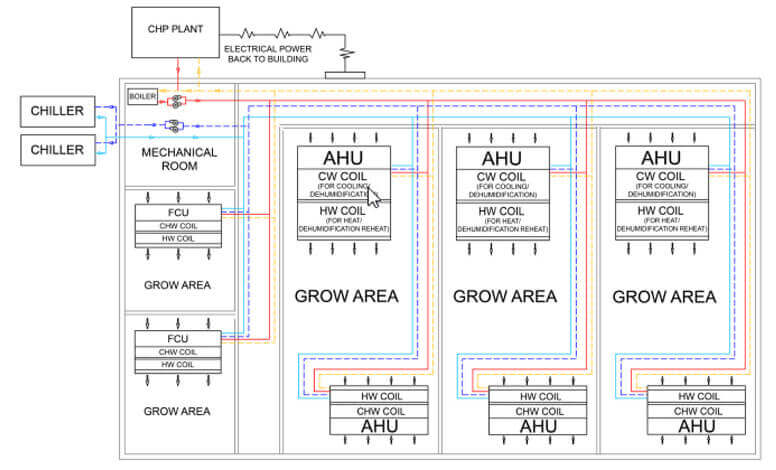Why Consider CHP
A maturing indoor cultivation industry is experiencing downward pricing pressure. Indoor food and cannabis growers are increasingly focused on making the upfront investments needed to reduce ongoing operating costs. As energy use is among the top recurring costs for cultivation companies, energy efficiency and reduction in energy costs are a significant component of reducing operating costs.
Utilizing combined heat and power, or CHP, in cultivation facilities, is a potential way to address both energy savings (with the potential to substantially reduce the cost of power), and energy efficiency (by producing significant amounts of thermal energy and carbon dioxide as a byproduct of producing electricity). The waste heat can then be reused for other energy consuming applications in the cultivation space, usually by applying it to energy hungry HVAC and dehumidification systems necessary for consistent climate control in grow spaces.
Cultivators can create energy savings initially by becoming their own energy producers and reducing or eliminating their grid electrical demand, but also by recycling excess heat to create a cogeneration system, resulting in reduced operational costs. Cultivators can expand the financial benefits of CHP by cleaning and reusing waste carbon dioxide to boost yields.
Integrate CHP With Your Grow Facility
Utilizing Combined Heat and Power (CHP)
Utilizing combined heat and power is a means by which some cultivation companies meet the overall energy requirements of their cultivation facilities when grid power may not be available, or the onsite generation of electricity may be preferable to obtaining grid power for various reasons outside of operational costs. In addition to producing power at a rate that is typically lower than the cost of grid power, utilizing CHP can also provide energy security for commercial cultivators by mitigating the risk of power outages and the unexpected downtime and crop loss that may result from loss of power.
While much attention is given to cultivation lighting as a major consumer of energy in cultivation facilities, most cultivators don’t realize that their environmental control systems will have energy demands equal to or even exceeding the energy demands of their cultivation lighting–in fact, the mechanical systems needed for maintaining the cultivation climate are sometimes the biggest energy consumers in the building. This is because of the massive amounts of sensible heat produced by the lighting, which directly affects air temperature, and the latent heat loads associated with irrigation and plant transpiration, which must also be removed to maintain appropriate humidity levels in cultivation of food crops and cannabis alike. Mechanical design plays a crucial role in the success of cultivation operations. Mechanical engineers who design cultivation environments should understand both how the systems need to perform inside the building, and how to optimize the design to mitigate the cost of energy for cultivators. Indoor food and cannabis growers are well served by employing design professionals like Surna Cultivation Technologies with significant experience in mechanical design specifically for cultivation, to help make design decisions that directly affect their yields, operating costs, and energy goals.
Utilizing Heat from Climate Control Systems
Utilizing the waste heat as a component of climate control systems is effectively an energy recycling system–in most combined heat and power plants, the prime mover (or engine) burns clean burning natural gas or other fuel to produce electricity, with thermal energy and carbon dioxide being produced as a byproduct. Those systems are typically water-cooled, where the thermal energy is transferred to a water supply using a radiator or other hydronic heat exchanger system, producing hot water as a byproduct. The engine producing electricity then effectively becomes a tool for heating water as well.
Hydronic (or chilled water) climate control systems are the types of systems that can best take advantage of the heat generation, utilizing heat from the hot water loop in a number of different ways. In hydronic systems, water is recirculated to fan coils or air handling units for cooling, heating and dehumidification, as opposed to refrigerant.

Methods To Leverage Hot Water For CHP in Cultivation Facilities
There are typically three methods in which the hot water can be utilized in hydronic climate control systems for cultivation facilities. All three options will result in substantial cost savings by reducing energy use, and all three must be carefully considered and incorporated during the early stages of facility design to best take advantage of the thermal benefit of CHP. Overall load requirements will be analyzed by the combined heat and power plant provider and the electrical and mechanical engineering team, with input from facility managers and cultivation teams to determine the best option for a particular facility.
Absorption Chillers
Absorption Chillers can be utilized to chill the water being recirculated through the fan coils or air handlers which are cooling and/or dehumidifying the cultivation space. The hot water from the CHP plant is utilized in place of a mechanical compressor to facilitate the vapor pressure cycle of the refrigerant in the unit. This can save energy by reducing the number of mechanical compressors in use for cooling and dehumidifying the facility. However, their output can be inconsistent, and maintaining them requires specialized expertise. From an engineering perspective, the heat produced by the CHP plant is not usually sufficient to power enough absorption chillers to manage the needs of the entire facility, and they may not be able to reach a low enough chilled water temperature to meet the dewpoint temperature required to effectively maintain climate parameters, so much of the chiller plant will still need to be traditional electric or gas-powered chillers. However, the implementation of absorption chillers can be a viable and beneficial means by which to utilize the heat produced by the plant in other industrial applications where dehumidification needs are less significant than in cultivation and may be an option in conjunction with other technologies in some limited cultivation applications.
Reheat for Dehumidification
Dehumidification in cultivation operations is primarily achieved by condensing moisture from its airborne gas form into liquid on the cooling coil of an air handler or fan coil, where it is then drained away. With 4-pipe chilled water systems, this is achieved by placing a heating coil after the cooling coil, allowing the cooling coil connected to the chilled water loop to be utilized for cooling and dehumidification functions, and then utilizing the reheat coil connected to the hot water loop to return the air temperature to to the desired condition before being returned to the space. This heat may be sourced through reheat chillers, external boilers, or when systems are incorporated with combined heat and power in cogeneration systems, from the waste heat from the prime mover. This waste heat utilization option reduces electricity and/or natural gas associated with boilers by preheating boiler feed water, or bypassing boilers entirely, and reduces or eliminates the need for heat recovery chillers (reducing associated costs), and is a very practical means by which to manage the massive humidity loads associated with indoor cultivation. 4-pipe chilled water systems can also provide exceptional environmental performance, typically resulting in the most tightly maintained climate parameters of the various systems used in cultivation. This is the most common use of the thermal energy benefit of CHP in cultivation facilities.
Comfort Heating
While cultivation lighting provides a significant amount of heat, in exceptionally cold environments where a low ambient temperature is common, comfort heating sometimes requires additional heating equipment such as furnaces and/or boilers. The waste heat produced by the CHP plant can entirely replace boilers and/or furnaces in most buildings, providing cold weather heat to the building via radiant floors, forced air, or radiators. There is no energy consumption associated with producing the heat as it is a byproduct of power generation, dramatically reducing the power consumed to only that which is consumed by pumps and/or fans. However, this only provides an outlet for the waste heat in cold weather scenarios, and therefore is unlikely to utilize all of the available waste heat throughout the year. In this case, it is recommended that there be a secondary use, such as those indicated above.
Additionally, mechanical CHP, which is an approach to power generation that uses the power produced onsite to directly operate a mechanical compressor, is also often incorporated in the indoor agriculture industry. With this type of system, commercial growers can operate energy efficient chillers whose compressors are directly powered by natural gas engines, and still reuse the thermal energy for their mechanical systems in any of the ways identified above. These types of systems are often incorporated in conjunction with grid power, or with whole facility CHP plants.

Getting Started with CHP For Your Cultivation Facility
Combined heat and power requires specialized maintenance expertise. Facility managers should be on staff who understand how the systems work and how they interact with the controls and HVAC systems. Facility managers are important team members in any cultivation facility, but they are exceptionally important as the systems being utilized increase in complexity and sophistication.
Using combined heat and power as a cogeneration system can be a major component of energy savings for cultivation companies. While the upfront costs may, in some cases, be higher than obtaining grid energy, there are a number of tax and financing incentives that make them increasingly attractive to cultivation companies. Their total lifecycle costs are typically much lower than grid power, and they should be carefully considered as an option to meet energy goals, environmental performance goals, and for cultivators who are seeking to incorporate renewable energy options in their facilities.

